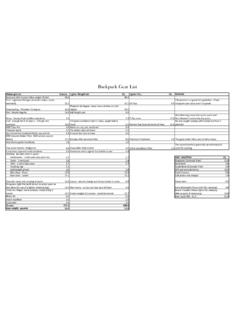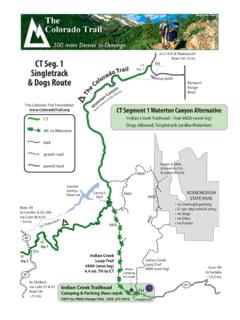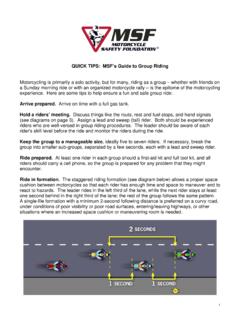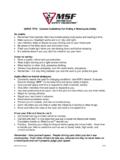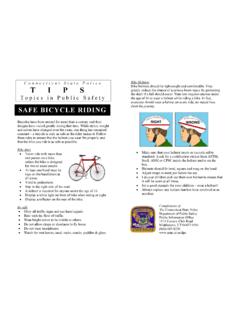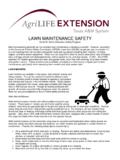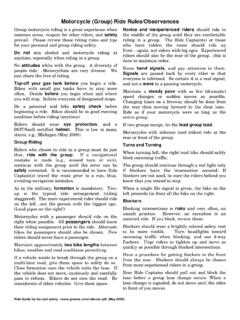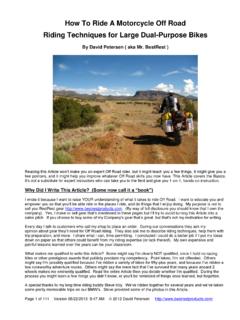Transcription of HORSE RIDING TIPS + CHECKLISTS FOR …
1 HORSE RIDING tips + CHECKLISTS FOR equipment & FOOD BY RICH JOHNSON, Golden, Colorado 303-877-0453 Here are some thoughts for RIDING horses on The Colorado Trail. These ideas apply to mules as well. I wrote these after RIDING horseback on the CT approximately 3 times, about 1,500 miles as of 2010. Shoe horses within 3-5 days of the trip. Use leather pads to protect the feet between shoe and hoof and fill the void with gel. Shoes with little or no tails are best. 4 nail the shoes on both sides. Check for loose shoes every night and tighten with a set of clinchers.
2 Have your farrier leave the nails a little long so that you have something to clinch with. Loose shoes will make a hollow or tinny sound when they strike a rock. Always listen for that sound and stop as soon as possible to inspect the shoe. Carry a couple of easy boots (or something similar) in case you lose a shoe. Generally you will want to ride high and camp low at night. Water can almost always be found at lower elevations and where there is water there is grass. My horses have always just foraged for themselves. Worm your horses before you leave on the trip and float their teeth if necessary.
3 During the day, stop 2 or 3 times for 20-30 minutes when you find good grass. Travel in small groups for less environmental impact. Travel light I pack only 60-80 pounds of food, water, equipment and clothing for a 2 week trip depending on the season I generally ride one HORSE for the day and use him as a pack animal the next day. Most horses will follow along without being led on a lead line when carrying a pack saddle. This gives them an opportunity to briefly stop as they travel and forage along the trail. At night I attach a 30 long 1 cotton lead line with bull snap to each horses halter.
4 The other end I attach to a log and let them pull the log around all night. Condition your HORSE to this way of being tied before the trip. This will cause the least amount of environmental damage and the HORSE will find the best feed for himself. The size of the log will vary in size from HORSE to HORSE . If the HORSE is a renegade and wants to leave all the time I will hobble his front feet in addition to attaching him to the log. If that doesn t work take the hobbles off and tie him to a tree or rock that he can t move. Be careful leaving the hobbles on night after night it will create sores where the leather touches his skin.
5 You can also use an aluminum stake driven into the ground to attach your lead line to. If your HORSE or horses leave during the middle of the night DON T PANIC. Look for their tracks. In almost every case they will get on the trail and head down hill. They will seldom go more than a mile. Use panniers made of Kevlar. Canvas panniers look nice but rip and tear easily when going through the trees. Take all loose items clothing, food and equipment and place in canvas gym bags before placing them in the panniers. This way you will have all your stuff when you get to camp.
6 Place your sleeping bag in a waterproof bag. I also like to use Kevlar saddle bags on my saddle HORSE . Decker metal framed pack saddles are best but wooden saw bucks are also adequate. All these items can be purchased at Davis Tent & Awning in Denver. Always double blanket any HORSE that is carrying either a saddle or pack saddle. Carry gall salve (from Murdocks) to doctor any wounds. This stuff really works and heals most injuries very quickly. I cover between 16-18 miles on an average day. After 2-3 days you will generally find that you and your horses will be working together as a team.
7 horses that are always nervous and don t eat when given the opportunity will not last on long trips. They wear themselves out in a very short period of time. When the weather is mild July & August I use a roll-a cot and make a shelter out of a 10 x 12 plastic tarp and 2 adjustable walking poles. I take my lariat and string it between 2 trees then drape the tarp over it attaching the rear of the tarp to the ground with tent stakes. I place the adjustable ski poles on the corners of the front of the tarp and attach guy wires to tent stakes. A little parachute cord works well for this.
8 The whole shelter weighs less than a pound and can be put up or taken down in a couple of minutes. Carry an axe to clear away downed timber on steep trails. On trails with very steep drop off untie your pack HORSE if he is tethered to your saddle HORSE . That way he won t pull you and your HORSE down the hill with you if he slips and falls. I recommend pulling your feet out of the stirrups or just barely placing your toes in the stirrups on trails with steep drop offs. If your HORSE slips or falls you at least have a chance of getting away from him and not being crushed or dragged down the hill.
9 ALWAYS THINK SAFETY FIRST especially if you are traveling alone. equipment checklist * Each Rider horses saddle w/ breast collar & rear tie down pack saddle w/ 2 kevlar panniers 4 saddle blankets (1 minimum thickness) * double blanket all horses Kevlar saddlebags ez boots (1 for each size hoof) shoeing tools clinchers, small hammer 2 halters 2 lead ropes 2 30 x 1 cotton ropes w/ bull snap 2 regular 1 leather hobbles head stall, bit, reins gall salve lariet orange surveyor ribbon during hunting season hoof pick Personal equipment Sunglasses 4 season tent (fall & winter months & rainy season)
10 Sleeping bag (rated to min 15 degrees) sleeping mat or paco pad survival blanket camp pillow head lamp w/ extra bulb extra AA batteries GPS Compass Whistle camera sunscreen (SPF 30) 4 empty stuff sacks small umbrella bowie knife (camp tool) sheath or folding knife leatherman first aid kit baby wipes (7 per day) plastic spade for digging cat hole Colorado Trail Guide Book tooth brush & tooth paste Personal equipment Continued dental floss deodorant antibacterial gel shampoo eye drops waterproof matches w/ plastic case butane lighter athletic tape 25 parachute cord elk call 10 x 12 plastic tarp crazy creek camp chair roll-a- cot (for sleeping outside)
